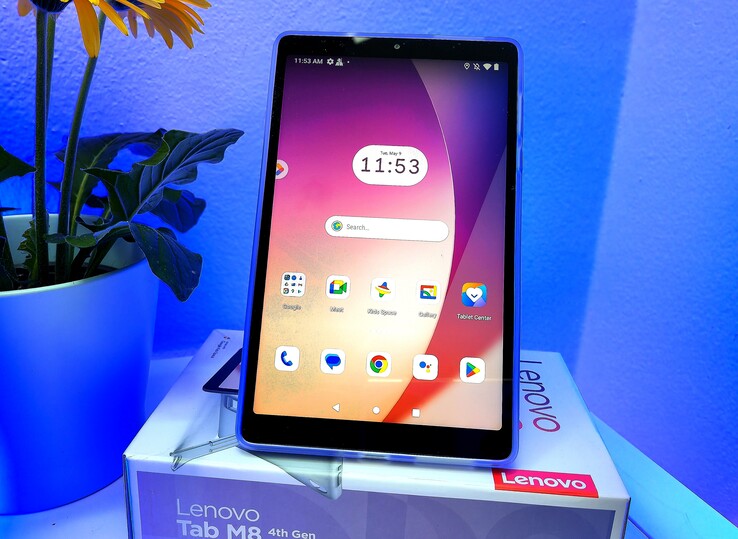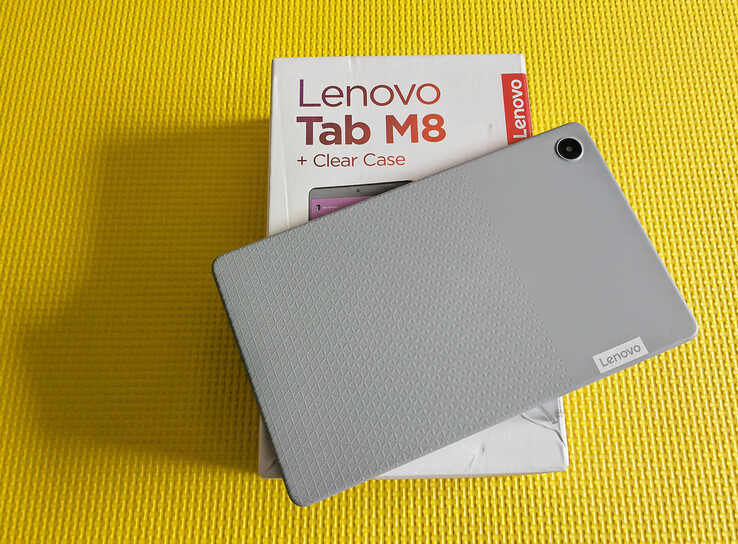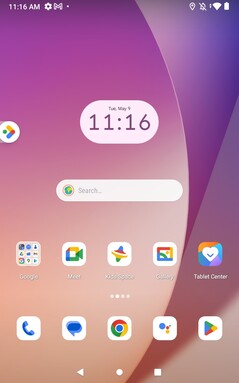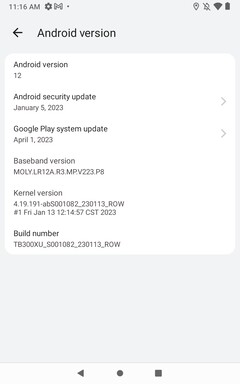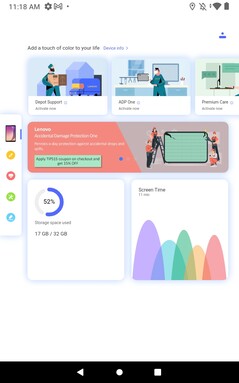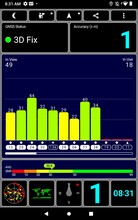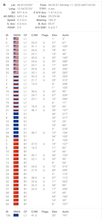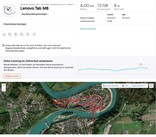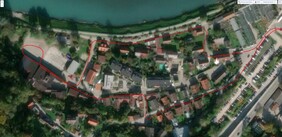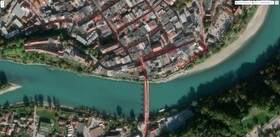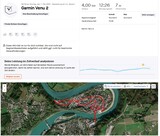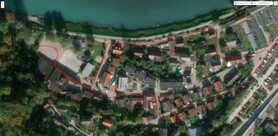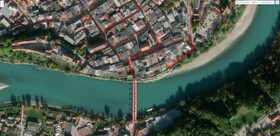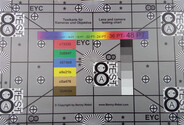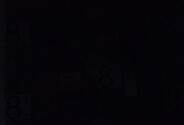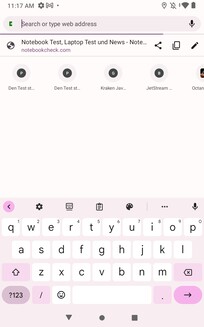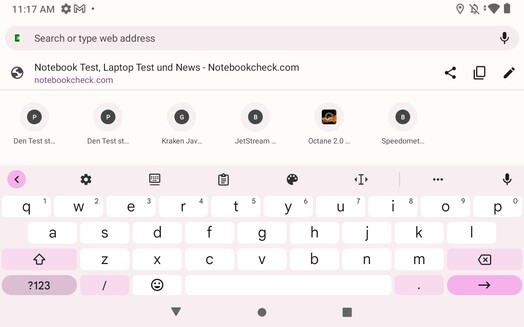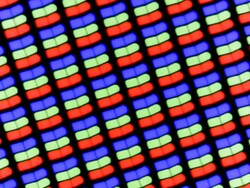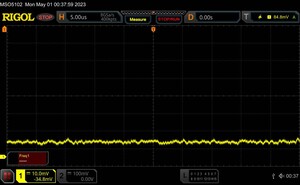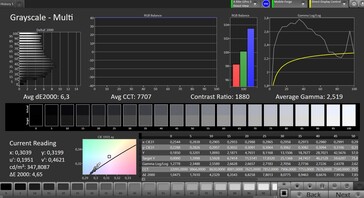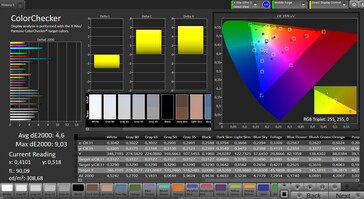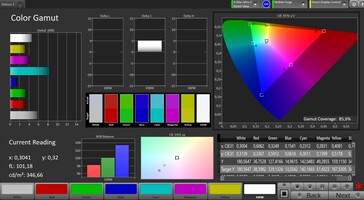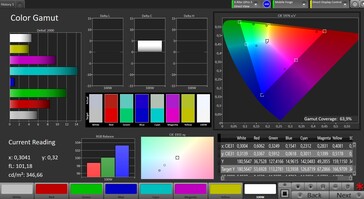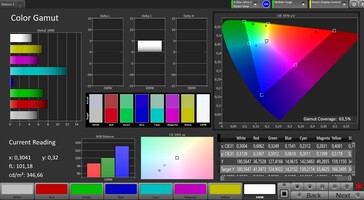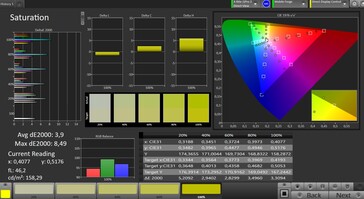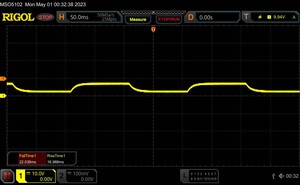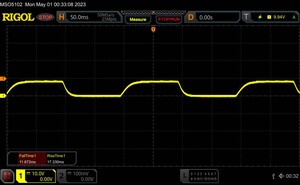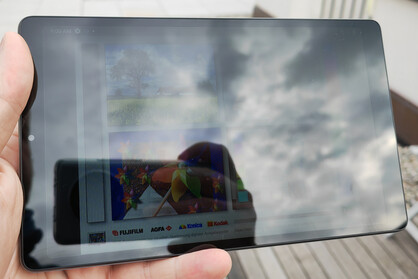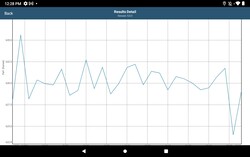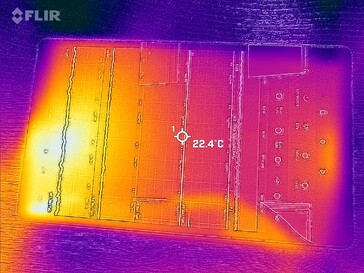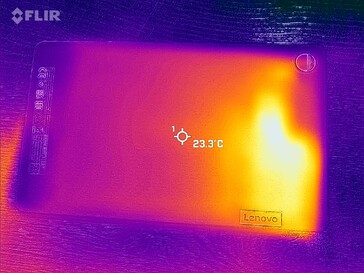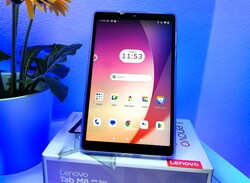Lenovo Tab M8 2023 (Gen 4) LTE tablet – A performance downgrade for the affordable 8-inch tablet
The 8-inch form factor is very handy as tablets this size can be stored away in a small bag. With mobile phone support and telephone functionality, this device can, if necessary, replace a smartphone, making this form factor offer an interesting compromise.
The Tab M8 2023 is already the fourth generation of Lenovo's affordable 8-inch tablet family and, at the time of reviewing, costs under $100 (non-LTE model) and is listed by various retailers with the device numbers TB300FU (WiFi version) and TB300XU (LTE version). We reviewed the LTE variant and wanted to know what has changed in the latest generation.
Possible competitors compared
Rating | Date | Model | Weight | Height | Size | Resolution | Price |
|---|---|---|---|---|---|---|---|
| 79.5 % v7 (old) | 05 / 2023 | Lenovo Tab M8 (Gen 4) Helio A22 MT6761, PowerVR GE8300 | 320 g | 9 mm | 8.00" | 1280x800 | |
| 80.8 % v7 (old) | 01 / 2023 | Lenovo Tab M8 (3rd Gen) Helio P22T MT8768T, PowerVR GE8320 | 305 g | 8.15 mm | 8.00" | 1280x800 | |
| 80.4 % v7 (old) | 01 / 2023 | Amazon Fire HD 8 2022 MT8169A, Mali-G52 MP2 | 337 g | 9.7 mm | 8.00" | 1280x800 | |
| 82.2 % v7 (old) | 02 / 2023 | Nokia T10 T7200 (T606), Mali-G57 MP1 | 375 g | 9 mm | 8.00" | 1280x800 | |
| 79.7 % v7 (old) | 08 / 2021 | Samsung Galaxy Tab A7 Lite Helio P22T MT8768T, PowerVR GE8320 | 366 g | 8 mm | 8.70" | 1340x800 |
Case – A slimmed down metal chassis
Just like its predecessor, the Tab M8 4th Gen is a very light tablet: Weighing 320 grams, it is considerably lighter than, for example, the Nokia T10 or the Samsung Galaxy Tab A7 Lite.
This fourth-generation tab is instantly recognisable on the outside: On the one hand, the Tab M8's rear side has a completely new design that is a nod to the Tab M9. Two-thirds of this area is covered in a triangular pattern while the top third is completely smooth and home to the Lenovo logo. Overall, the chassis is slightly textured and is made of metal which helps give the Tab M8 2023 a premium look.
The predecessor, the Tab M8 Gen 3, was actually a little slimmer. However, this time Lenovo has managed to shrink the display's frame. Overall, this has helped the chassis enjoy a more compact form. Nevertheless, we're talking millimetres when it comes to the differences between the two devices.
The tablet's stability is quite impressive and although slight twisting is possible, the search for creaking noises ended in vain.
Features – Also available with more storage
Generally, you shouldn't expect much in the way of RAM or mass storage for under $150. Nevertheless, Lenovo has various options on offer for its Tab M8 4th Gen (RRP):
- Lenovo Tab M8 4th Gen WiFi – 32 GB storage, 3 GB of RAM: $108
- Lenovo Tab M8 4th Gen WiFi – 64 GB storage, 4 GB of RAM: $149
- Lenovo Tab M8 4th Gen LTE – 32 GB storage, 3 GB of RAM: $161
Currently, a variant with LTE and 64 GB of storage is not available in central Europe. Therefore, the ex-factory prices are very similar and sometimes even lower than the predecessor.
Likewise, the tablet has a USB-C port and also a 3.5mm audio jack. For such a nifty tablet, an NFC chip might have been worthwhile but Lenovo has decided against this.
MicroSD card reader
The microSD reader can handle cards up to 128 GB. Our tests with the microSD Angelbird V60 reference card showed its data transfer speeds to be on par with similar devices in this category. However, the Samsung Galaxy Tab A7 Lite proves that it's possible to squeeze much more out of the card.
| SD Card Reader - average JPG Copy Test (av. of 3 runs) | |
| Samsung Galaxy Tab A7 Lite (Toshiba Exceria Pro M501) | |
| Nokia T10 (Angelbird V60) | |
| Lenovo Tab M8 (Gen 4) (Angelbird V60) | |
| Amazon Fire HD 8 2022 (Angelbird V60) | |
| Lenovo Tab M8 (3rd Gen) (Angelbird V60) | |
Cross Platform Disk Test (CPDT)
Software – Updates until 2026
Android 12 is preinstalled on the tablet and has one advantage over its predecessor: The 4th gen kicks off with a more modern Android version and, according to the manufacturer, the device will receive an update to Android 13 in the third quarter of 2023.
In addition, security patches are planned until 2026 although these happen quite infrequently. At the time of reviewing, our 4th gen Tab M8 had to make do with security updates from January 2023.
What is pleasing is that Lenovo has installed pure Android on the tablet and that the device is mostly devoid of third-party apps.
Communication and GNSS – Excellent location accuracy
The Tab M8 2023 comes in a Wi-Fi and an LTE variant with our review device able to connect to the cellular network and can even be used to make calls via the speakers or a headset. However, only one SIM slot is present.
Network reception is decent but in our tests, it didn't quite manage the level achieved by high-end smartphones. The range of LTE frequencies is sufficient for operation in Europe but for trips further afield, we would recommend checking the frequencies necessary for mobile internet in the target destination.
Every variant of the Tab M8 comes with Wi-Fi 5, and, in doing so, the tablet manages Wi-Fi speeds typical for this category of device. Data transfer speeds are also very stable. Nearby the router, the reception is very good and at a distance of 10 meters, half the signal strength is available with pages then loading somewhat slower.
| Networking | |
| iperf3 transmit AX12 | |
| Samsung Galaxy Tab A7 Lite | |
| iperf3 receive AX12 | |
| Samsung Galaxy Tab A7 Lite | |
| iperf3 receive AXE11000 | |
| Amazon Fire HD 8 2022 | |
| Lenovo Tab M8 (3rd Gen) | |
| Nokia T10 | |
| Lenovo Tab M8 (Gen 4) | |
| iperf3 transmit AXE11000 | |
| Amazon Fire HD 8 2022 | |
| Lenovo Tab M8 (Gen 4) | |
| Lenovo Tab M8 (3rd Gen) | |
| Nokia T10 | |
Both the Wi-Fi and the LTE versions of the Tab M8 2023 have a satellite tracking module that supports GPS, Glonass, Galileo and Beidou as well as SBAS for even greater accuracy. Stepping outdoors, numerous satellites were detected quickly and we were located to within one meter of our exact location - a very good value indeed.
It goes without saying, we also wanted to put the device to the test in a practical test environment so we set off on a bike trip. Our comparison device: The Garmin Venu 2. The Tab M8 2023 also didn't disappoint in this area with exact positioning which only suffered slightly in narrow lanes. This means this handy little tablet can also be used as a navigation device.
Cameras – Only the basics
Tablets, and especially those in a low price bracket, are not well known for the quality of their camera photos. At first glance, it is clear this is also not likely to be any different with the Tab M8 4th gen: The same camera features are at work here as its predecessor such as a spartan 5-megapixel camera on the back and a 2-megapixel sensor on the front.
The rear-facing main camera has problems handling difficult situations such as backlight and often seems to be out of its depth. In low light, images are out of focus and dark areas are only marginally brightened.
1080p, 30 fps videos are possible but the quality here leaves a lot to be desired.
The front-facing camera also takes blurry selfies with dark areas such as hair refusing to reveal details of any kind.
Image comparison
Choose a scene and navigate within the first image. One click changes the position on touchscreens. One click on the zoomed-in image opens the original in a new window. The first image shows the scaled photograph of the test device.
Hauptkamera BlumeHauptkamera UmgebungHauptkamera LowLightAt full studio lighting, the main camera is similarly short on competence as blurry areas are visible and details get lost. At a luminosity of 1 lux, the image is completely black.
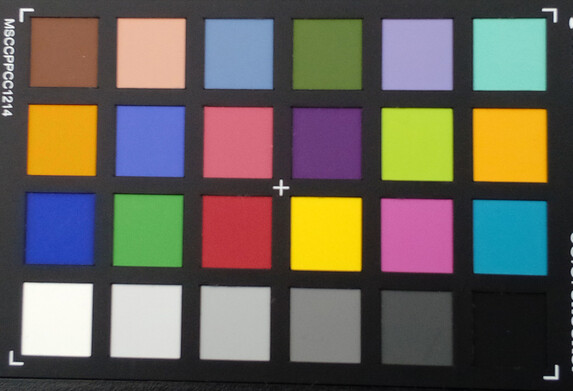

Accessories and guarantee – A protective case is included
The tablet comes with a charger, a USB-C cable and a SIM tool. Fortunately, Lenovo has also included a protective case which has a fold-out stand.
The manufacturer's tablets come with a 24-month guarantee provided they are purchased in the EU.
Input devices & operation – Not always accurate
Basically, the tablet's 60 Hz screen is easy to use but is not very responsive at the edges. This means the user sometimes has to repeat certain gestures, for example, when trying to open the notification panel.
In this price range, it is not unusual to find that the tablet lacks a fingerprint sensor. However, we were even more surprised when we accessed the security menu: Face unlocking is also not possible meaning there is no biometric method of unlocking the device.
Display – Brighter but lacking HD streams
Lenovo has continued to opt for an IPS display with 1280 x 800 pixels that is now a little brighter than the previous gen model, the Tab M8. With an average brightness of 380 cd/m², the tablet fares well when compared to its similarly priced peers. The low black levels also manage to impress and allow the screen to display saturated colors.
It is, however, annoying that the tablet only uses Widevine L3 making it impossible to stream content from major providers in HD quality.
We were unable to detect any PWM flickering even at low brightness.
| |||||||||||||||||||||||||
Brightness Distribution: 86 %
Center on Battery: 410 cd/m²
Contrast: 2563:1 (Black: 0.16 cd/m²)
ΔE ColorChecker Calman: 4.6 | ∀{0.5-29.43 Ø4.83}
ΔE Greyscale Calman: 6.3 | ∀{0.09-98 Ø5.1}
85.6% sRGB (Calman 2D)
Gamma: 2.519
CCT: 7707 K
| Lenovo Tab M8 (Gen 4) IPS, 1280x800, 8" | Lenovo Tab M8 (3rd Gen) IPS, 1280x800, 8" | Amazon Fire HD 8 2022 LCD, 1280x800, 8" | Nokia T10 IPS, 1280x800, 8" | Samsung Galaxy Tab A7 Lite TFT, 1340x800, 8.7" | |
|---|---|---|---|---|---|
| Screen | -62% | -18% | -44% | -28% | |
| Brightness middle | 410 | 353 -14% | 388 -5% | 446 9% | 360 -12% |
| Brightness | 380 | 330 -13% | 364 -4% | 429 13% | 332 -13% |
| Brightness Distribution | 86 | 81 -6% | 90 5% | 94 9% | 85 -1% |
| Black Level * | 0.16 | 0.64 -300% | 0.36 -125% | 0.65 -306% | 0.24 -50% |
| Contrast | 2563 | 552 -78% | 1078 -58% | 686 -73% | 1500 -41% |
| Colorchecker dE 2000 * | 4.6 | 6.5 -41% | 4.38 5% | 4.87 -6% | 6.7 -46% |
| Colorchecker dE 2000 max. * | 9.03 | 11.36 -26% | 10.7 -18% | 9.85 -9% | 12.4 -37% |
| Greyscale dE 2000 * | 6.3 | 7.3 -16% | 2.9 54% | 5.7 10% | 7.6 -21% |
| Gamma | 2.519 87% | 2.118 104% | 2.232 99% | 2.189 101% | 2.33 94% |
| CCT | 7707 84% | 8264 79% | 6221 104% | 7781 84% | 8744 74% |
* ... smaller is better
Screen Flickering / PWM (Pulse-Width Modulation)
| Screen flickering / PWM not detected | |||
In comparison: 53 % of all tested devices do not use PWM to dim the display. If PWM was detected, an average of 8320 (minimum: 5 - maximum: 343500) Hz was measured. | |||
Apart from colors being a little too dark in our tests with the CalMAN software as well as the presence of a slight blue hue, the tablet scores quite well in the area of color reproduction.
Response times for gamers are clearly too slow.
Display Response Times
| ↔ Response Time Black to White | ||
|---|---|---|
| 39 ms ... rise ↗ and fall ↘ combined | ↗ 22 ms rise | |
| ↘ 17 ms fall | ||
| The screen shows slow response rates in our tests and will be unsatisfactory for gamers. In comparison, all tested devices range from 0.1 (minimum) to 240 (maximum) ms. » 96 % of all devices are better. This means that the measured response time is worse than the average of all tested devices (20.5 ms). | ||
| ↔ Response Time 50% Grey to 80% Grey | ||
| 29.2 ms ... rise ↗ and fall ↘ combined | ↗ 11.9 ms rise | |
| ↘ 17.3 ms fall | ||
| The screen shows relatively slow response rates in our tests and may be too slow for gamers. In comparison, all tested devices range from 0.165 (minimum) to 636 (maximum) ms. » 37 % of all devices are better. This means that the measured response time is similar to the average of all tested devices (32 ms). | ||
Performance – Hardly worth mentioning
The SoC has suffered a noticeable backwards step compared to its predecessor: Back then, the manufacturer opted for a MediaTek Helio P22 with 8 cores and a maximum of 2.3 GHz and now the Lenovo Tab M8 Gen 4 uses the Helio A22 with cores 4 and maximum of 2 GHz. It's already possible to guess what that means in terms of performance.
The Lenovo Tab M8 2023 is fighting a losing battle, especially when it comes to multi-core applications: Almost all comparison devices are at least twice as fast in benchmark tests. Only the Amazon Fire HD 8 2022 is as slow as our review device.
In everyday use and even when opening menus, the tablet doesn't enjoy completely stutter-free navigation. More complex apps turn into a slideshow of images that are almost impossible to use.
| Antutu v9 - Total Score | |
| Average of class Tablet (105826 - 1286774, n=35, last 2 years) | |
| Amazon Fire HD 8 2022 | |
| Samsung Galaxy Tab A7 Lite | |
| Lenovo Tab M8 (Gen 4) | |
| Average Mediatek Helio A22 MT6761 (n=1) | |
| CrossMark - Overall | |
| Average of class Tablet (172 - 2155, n=67, last 2 years) | |
| Lenovo Tab M8 (Gen 4) | |
| Average Mediatek Helio A22 MT6761 (n=1) | |
| Amazon Fire HD 8 2022 | |
| AImark - Score v3.x | |
| Average of class Tablet (138 - 156427, n=59, last 2 years) | |
| Lenovo Tab M8 (Gen 4) | |
| Average Mediatek Helio A22 MT6761 (n=1) | |
The Tab M8 is also anything but convincing in the area of graphics performance. Many modern apps didn't even boot but the SoC is, after all, 5 years old. Also, in almost every possible test, the Tab M8 Gen 4 found itself at the bottom of the pack, and by some margin.
GFXBench 3.0: on screen Manhattan Onscreen OGL | 1920x1080 1080p Manhattan Offscreen
GFXBench 3.1: on screen Manhattan ES 3.1 Onscreen | 1920x1080 Manhattan ES 3.1 Offscreen
GFXBench: on screen Car Chase Onscreen | 1920x1080 Car Chase Offscreen | on screen Aztec Ruins High Tier Onscreen | 2560x1440 Aztec Ruins High Tier Offscreen | on screen Aztec Ruins Normal Tier Onscreen | 1920x1080 Aztec Ruins Normal Tier Offscreen | 3840x2160 4K Aztec Ruins High Tier Offscreen
3DMark: 2560x1440 Sling Shot OpenGL ES 3.0 | 2560x1440 Sling Shot OpenGL ES 3.0 Graphics | 2560x1440 Sling Shot OpenGL ES 3.0 Physics | 2560x1440 Sling Shot OpenGL ES 3.0 Unlimited | 2560x1440 Sling Shot OpenGL ES 3.0 Unlimited Graphics | 2560x1440 Sling Shot OpenGL ES 3.0 Unlimited Physics
| GFXBench (DX / GLBenchmark) 2.7 / T-Rex Onscreen | |
| Amazon Fire HD 8 2022 | |
| Samsung Galaxy Tab A7 Lite | |
| Lenovo Tab M8 (Gen 4) | |
| GFXBench (DX / GLBenchmark) 2.7 / T-Rex Offscreen | |
| Amazon Fire HD 8 2022 | |
| Samsung Galaxy Tab A7 Lite | |
| Lenovo Tab M8 (Gen 4) | |
| GFXBench 3.0 / Manhattan Onscreen OGL | |
| Amazon Fire HD 8 2022 | |
| Samsung Galaxy Tab A7 Lite | |
| Lenovo Tab M8 (Gen 4) | |
| GFXBench 3.0 / 1080p Manhattan Offscreen | |
| Amazon Fire HD 8 2022 | |
| Samsung Galaxy Tab A7 Lite | |
| Lenovo Tab M8 (Gen 4) | |
| GFXBench 3.1 / Manhattan ES 3.1 Onscreen | |
| Amazon Fire HD 8 2022 | |
| Samsung Galaxy Tab A7 Lite | |
| Lenovo Tab M8 (Gen 4) | |
| GFXBench 3.1 / Manhattan ES 3.1 Offscreen | |
| Amazon Fire HD 8 2022 | |
| Samsung Galaxy Tab A7 Lite | |
| Lenovo Tab M8 (Gen 4) | |
| GFXBench / Car Chase Onscreen | |
| Amazon Fire HD 8 2022 | |
| Samsung Galaxy Tab A7 Lite | |
| Lenovo Tab M8 (Gen 4) | |
| GFXBench / Car Chase Offscreen | |
| Amazon Fire HD 8 2022 | |
| Samsung Galaxy Tab A7 Lite | |
| Lenovo Tab M8 (Gen 4) | |
| GFXBench / Aztec Ruins High Tier Onscreen | |
| Nokia T10 | |
| Amazon Fire HD 8 2022 | |
| Lenovo Tab M8 (3rd Gen) | |
| Samsung Galaxy Tab A7 Lite | |
| Lenovo Tab M8 (Gen 4) | |
| GFXBench / Aztec Ruins High Tier Offscreen | |
| Amazon Fire HD 8 2022 | |
| Nokia T10 | |
| Samsung Galaxy Tab A7 Lite | |
| Lenovo Tab M8 (3rd Gen) | |
| Lenovo Tab M8 (Gen 4) | |
| GFXBench / Aztec Ruins Normal Tier Onscreen | |
| Amazon Fire HD 8 2022 | |
| Nokia T10 | |
| Lenovo Tab M8 (3rd Gen) | |
| Samsung Galaxy Tab A7 Lite | |
| Lenovo Tab M8 (Gen 4) | |
| GFXBench / Aztec Ruins Normal Tier Offscreen | |
| Amazon Fire HD 8 2022 | |
| Nokia T10 | |
| Lenovo Tab M8 (3rd Gen) | |
| Samsung Galaxy Tab A7 Lite | |
| Lenovo Tab M8 (Gen 4) | |
| GFXBench / 4K Aztec Ruins High Tier Offscreen | |
| Nokia T10 | |
| Lenovo Tab M8 (3rd Gen) | |
| Lenovo Tab M8 (Gen 4) | |
| 3DMark / Sling Shot OpenGL ES 3.0 | |
| Samsung Galaxy Tab A7 Lite | |
| Lenovo Tab M8 (Gen 4) | |
| Amazon Fire HD 8 2022 | |
| 3DMark / Sling Shot OpenGL ES 3.0 Graphics | |
| Samsung Galaxy Tab A7 Lite | |
| Lenovo Tab M8 (Gen 4) | |
| 3DMark / Sling Shot OpenGL ES 3.0 Physics | |
| Lenovo Tab M8 (Gen 4) | |
| Samsung Galaxy Tab A7 Lite | |
| 3DMark / Sling Shot OpenGL ES 3.0 Unlimited | |
| Samsung Galaxy Tab A7 Lite | |
| Lenovo Tab M8 (Gen 4) | |
| 3DMark / Sling Shot OpenGL ES 3.0 Unlimited Graphics | |
| Samsung Galaxy Tab A7 Lite | |
| Lenovo Tab M8 (Gen 4) | |
| 3DMark / Sling Shot OpenGL ES 3.0 Unlimited Physics | |
| Lenovo Tab M8 (Gen 4) | |
| Samsung Galaxy Tab A7 Lite | |
Browser benchmarks offered the Tab M8 2023 ray of hope with the device even managing to secure first place, ahead of its peers.
However, in practice, our observations quickly dampened this positivity: Pages took an eternity to load. However, even with a 1,000 MBit connection, you can expect to wait a long time, especially for images.
| Jetstream 2 - 2.0 Total Score | |
| Average of class Tablet (19.9 - 393, n=74, last 2 years) | |
| Amazon Fire HD 8 2022 (Silk Browser 106) | |
| Lenovo Tab M8 (Gen 4) (Chrome 112) | |
| Samsung Galaxy Tab A7 Lite (Chrome 92.0.4515.115) | |
| Average Mediatek Helio A22 MT6761 (13.4 - 20.3, n=6) | |
| WebXPRT 4 - Overall | |
| Average of class Tablet (21 - 315, n=75, last 2 years) | |
| Amazon Fire HD 8 2022 (Silk Browser 106) | |
| Lenovo Tab M8 (Gen 4) (Chrome 112) | |
| Average Mediatek Helio A22 MT6761 (n=1) | |
| WebXPRT 3 - Overall | |
| Average of class Tablet (36 - 435, n=35, last 2 years) | |
| Lenovo Tab M8 (Gen 4) (Chrome 112) | |
| Samsung Galaxy Tab A7 Lite (Chrome 92.0.4515.115) | |
| Amazon Fire HD 8 2022 (Silk Browser 106) | |
| Average Mediatek Helio A22 MT6761 (30 - 39, n=6) | |
| Speedometer 2.0 - Result | |
| Average of class Tablet (2.59 - 572, n=64, last 2 years) | |
| Amazon Fire HD 8 2022 (Silk Browser 106) | |
| Lenovo Tab M8 (Gen 4) (Chome 112) | |
| Average Mediatek Helio A22 MT6761 (12.5 - 15.7, n=5) | |
| Samsung Galaxy Tab A7 Lite (Chrome 92.0.4515.115) | |
| Octane V2 - Total Score | |
| Average of class Tablet (763 - 111219, n=101, last 2 years) | |
| Nokia T10 (Chrome 109) | |
| Amazon Fire HD 8 2022 (Silk Browser 106) | |
| Samsung Galaxy Tab A7 Lite (Chrome 92.0.4515.115) | |
| Lenovo Tab M8 (Gen 4) (Chrome 112) | |
| Lenovo Tab M8 (3rd Gen) (Chrome 109) | |
| Average Mediatek Helio A22 MT6761 (3920 - 5041, n=8) | |
| Mozilla Kraken 1.1 - Total | |
| Samsung Galaxy Tab A7 Lite (Chrome 92.0.4515.115) | |
| Average Mediatek Helio A22 MT6761 (9310 - 12215, n=6) | |
| Amazon Fire HD 8 2022 (Silk Browser 106) | |
| Lenovo Tab M8 (Gen 4) (Chrome 112) | |
| Average of class Tablet (319 - 34733, n=84, last 2 years) | |
* ... smaller is better
With its eMMC flash, the Tab M8 2023 is also unable to pull away from its affordable competitors but still manages to remain at its class level. You shouldn't expect either quick loading times or speedy data transfer.
| Lenovo Tab M8 (Gen 4) | Lenovo Tab M8 (3rd Gen) | Amazon Fire HD 8 2022 | Nokia T10 | Samsung Galaxy Tab A7 Lite | Average 32 GB eMMC Flash | Average of class Tablet | |
|---|---|---|---|---|---|---|---|
| AndroBench 3-5 | -38% | -25% | 52% | 1% | -25% | 488% | |
| Sequential Read 256KB | 269.6 | 262.1 -3% | 270.37 0% | 273.5 1% | 271.1 1% | 242 ? -10% | 1425 ? 429% |
| Sequential Write 256KB | 190.5 | 66.7 -65% | 113.44 -40% | 191.5 1% | 87.2 -54% | 100.5 ? -47% | 1022 ? 436% |
| Random Read 4KB | 67 | 50.8 -24% | 39.46 -41% | 71.4 7% | 60.8 -9% | 43.1 ? -36% | 217 ? 224% |
| Random Write 4KB | 23.9 | 9.9 -59% | 19.81 -17% | 71.5 199% | 39.51 65% | 22.3 ? -7% | 230 ? 862% |
Games – Gaming at minimum standards
Due to its low-level performance, gaming tests were also difficult: Many games refused to boot with only the 10-year-old Asphalt 8 willing to cooperate. This game was playable in low detail settings at around 29fps. Higher settings lead to significant drops in frame rates and are problematic when it comes to fast racing games.
PUBG Mobile is also playable thanks to its various settings options. However, this is not fun when the game struggles to run at 20fps, even at the lowest settings. We used the Gamebench software to measure the frame rates.
Emissions – No throttling
Temperature
Even after periods of extensive load, the tablet didn't really heat up, reaching a maximum of 30.1 °C.
Unfortunately, the SoC struggled with the 3DMark stress test which meant we had to turn to GFXBench. Here we witnessed consistent levels of performance even under continuous load.
(+) The maximum temperature on the upper side is 28.6 °C / 83 F, compared to the average of 33.7 °C / 93 F, ranging from 20.7 to 53.2 °C for the class Tablet.
(+) The bottom heats up to a maximum of 30.1 °C / 86 F, compared to the average of 33.2 °C / 92 F
(+) In idle usage, the average temperature for the upper side is 22.8 °C / 73 F, compared to the device average of 30 °C / 86 F.
Speakers
At least the Lenovo Tab M8 has two real stereo speakers at its disposal but the effect thereof is rather modest due to their close proximity to one another. However, if desired, the speakers can get relatively loud and although they sound somewhat hollow, they are still good considering the price category.
In addition to the 3.5mm audio jack, Bluetooth 5.0 is on board and ensures connectivity to external audio devices. When it comes to codecs, pretty much standard fare is on offer: SBC, AAC, aptX, aptX HD and LDAC.
Lenovo Tab M8 (Gen 4) audio analysis
(±) | speaker loudness is average but good (80.2 dB)
Bass 100 - 315 Hz
(-) | nearly no bass - on average 26.2% lower than median
(±) | linearity of bass is average (11.9% delta to prev. frequency)
Mids 400 - 2000 Hz
(±) | higher mids - on average 6.7% higher than median
(±) | linearity of mids is average (10.1% delta to prev. frequency)
Highs 2 - 16 kHz
(±) | higher highs - on average 5.3% higher than median
(±) | linearity of highs is average (9.6% delta to prev. frequency)
Overall 100 - 16.000 Hz
(±) | linearity of overall sound is average (28.1% difference to median)
Compared to same class
» 86% of all tested devices in this class were better, 3% similar, 11% worse
» The best had a delta of 7%, average was 21%, worst was 129%
Compared to all devices tested
» 84% of all tested devices were better, 3% similar, 13% worse
» The best had a delta of 4%, average was 24%, worst was 134%
Samsung Galaxy Tab A7 Lite audio analysis
(+) | speakers can play relatively loud (85.5 dB)
Bass 100 - 315 Hz
(-) | nearly no bass - on average 24% lower than median
(±) | linearity of bass is average (9.7% delta to prev. frequency)
Mids 400 - 2000 Hz
(±) | higher mids - on average 6.2% higher than median
(+) | mids are linear (5.5% delta to prev. frequency)
Highs 2 - 16 kHz
(±) | higher highs - on average 6.4% higher than median
(+) | highs are linear (4.5% delta to prev. frequency)
Overall 100 - 16.000 Hz
(±) | linearity of overall sound is average (22.4% difference to median)
Compared to same class
» 66% of all tested devices in this class were better, 5% similar, 29% worse
» The best had a delta of 7%, average was 21%, worst was 129%
Compared to all devices tested
» 64% of all tested devices were better, 6% similar, 30% worse
» The best had a delta of 4%, average was 24%, worst was 134%
Energy management – High consumption under low load
Energy consumption
Under low load, the Tab M8 2023 requires a relatively high amount of energy but is still able to reign itself in at high-performance levels. Power consumption remained very consistent throughout our tests.
The tablet can handle a maximum of 10 watts of charging power meaning it can take up to 3 hours to fully recharge the 5100 mAh battery.
| Off / Standby | |
| Idle | |
| Load |
|
Key:
min: | |
| Lenovo Tab M8 (Gen 4) 5100 mAh | Amazon Fire HD 8 2022 4850 mAh | Samsung Galaxy Tab A7 Lite 5100 mAh | |
|---|---|---|---|
| Power Consumption | 18% | -21% | |
| Idle Minimum * | 1.7 | 1.2 29% | 0.78 54% |
| Idle Average * | 1.9 | 1.4 26% | 2.88 -52% |
| Idle Maximum * | 2.4 | 1.7 29% | 2.91 -21% |
| Load Average * | 3 | 2.5 17% | 4 -33% |
| Load Maximum * | 3.9 | 4.3 -10% | 6.04 -55% |
* ... smaller is better
Power consumption: Geekbench (150 cd/m²)
Power consumption: GFXBench (150 cd/m²)
Battery life
At 15.29 hours in our Wi-Fi test, the tablet manages quite good battery life but is still somewhat worse than its predecessor as well as some other tablets in this price range. The other runtime scenarios are ok without standing out.
All in all, under medium load, it's possible to use the Lenovo Tab M8 2023 for a number of days without seeing any noticeable difference in battery life compared to other cheap tablets.
| Lenovo Tab M8 (Gen 4) 5100 mAh | Lenovo Tab M8 (3rd Gen) 5000 mAh | Amazon Fire HD 8 2022 4850 mAh | Nokia T10 5250 mAh | Samsung Galaxy Tab A7 Lite 5100 mAh | |
|---|---|---|---|---|---|
| Battery Runtime | 4% | 1% | 6% | -4% | |
| Reader / Idle | 2223 | 2463 11% | |||
| H.264 | 998 | 800 -20% | |||
| WiFi v1.3 | 929 | 962 4% | 935 1% | 984 6% | 803 -14% |
| Load | 229 | 245 7% |
Pros
Cons
Verdict – The Tab M8 2023 has a performance problem
What was Lenovo thinking? Even the Lenovo Tab M8 2023's (Gen 4) predecessor was, for its price point, a fairly slow tablet. And now Lenovo has simply managed to equip its successor with an even slower SoC.
Otherwise, some progress has definitely been made: Decent sounding stereo speakers, a more compact case, excellent location function, more modern software and a brighter display. However, battery life is shorter despite having a more powerful battery and face unlocking is also absent.
When it comes to the fifth generation of its affordable tablet, Lenovo will have to equip its device with more powerful components as this current tablet has already been left hopelessly behind by its peers in this category of tablet.
The Lenovo Tab M8 2023 (Gen 4) LTE is a low-priced tablet with cellular functionality that has definitely skimped too much on performance.
The predecessor, the Lenovo Tab M8 2022 (Gen 3), offers a more well-rounded package but is, nevertheless, not exactly the fastest tablet. The Nokia T10 offers significantly more power.
Price and availability
At the time of review, the 32 GB mass storage, Wi-Fi variant of the Lenovo Tab M8 can be had on Lenovo's online store for just under $95.
The 64 GB mass storage model currently costs significantly more and is hard to come by. Even on Lenovo's own online store, this model of the tablet is currently unavailable.
Lenovo Tab M8 (Gen 4)
- 05/11/2023 v7 (old)
Florian Schmitt
Transparency
The selection of devices to be reviewed is made by our editorial team. The test sample was provided to the author as a loan by the manufacturer or retailer for the purpose of this review. The lender had no influence on this review, nor did the manufacturer receive a copy of this review before publication. There was no obligation to publish this review. We never accept compensation or payment in return for our reviews. As an independent media company, Notebookcheck is not subjected to the authority of manufacturers, retailers or publishers.
This is how Notebookcheck is testing
Every year, Notebookcheck independently reviews hundreds of laptops and smartphones using standardized procedures to ensure that all results are comparable. We have continuously developed our test methods for around 20 years and set industry standards in the process. In our test labs, high-quality measuring equipment is utilized by experienced technicians and editors. These tests involve a multi-stage validation process. Our complex rating system is based on hundreds of well-founded measurements and benchmarks, which maintains objectivity. Further information on our test methods can be found here.




